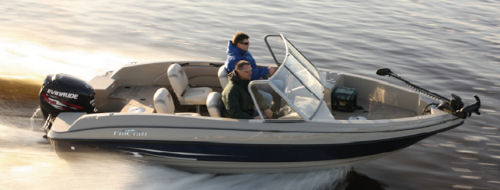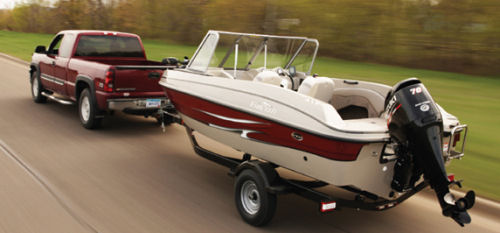Is FinCraft A Game Changer?
We all know that the world is rapidly changing and while no one knows what it will be like when we get on the other side
of (whatever you want to call it), we all know the world will be different. Now
everyone, even the fat cats, are watching every penny and are considering brands
they never would have looked at before because some of them have real value for
money. For that reason, there couldn’t be a better time for the launch of FinCraft,
a new brand of freshwater multi-specie fiberglass fishing boat with a price tag
that makes aluminum boat builders apoplectic. The new FinCraft 17, with 50-hp outboard
and trailer, has an MSRP of $14k and the street price is even less. The parent company,
Genmar, says that with $3k down, they estimate someone can get into the FinCraft
17 for as little as $136 per month. Where we come from, that means we’ll have to
give up two large Dunkin' Donuts’ coffees a day, and brew it ourselves. Think about
it. Smokers could kick the habit and have enough extra monthly money to go for the
big engine, to say nothing of not dying of emphysema. There probably isn’t a working
person alive in the U.S. who couldn’t trade one of his little “luxuries” or vices
for a FinCraft, if he really wanted to go boating bad enough. That’s why we think
these three models – the 17 SC or 17 DC and the 1850 DC -- could
be “game changers.”
There is a large portion of our readers who don’t remember what the 1950s were like,
but we can tell you that it was an exciting time in America for boating. There were
a dozen companies making outboard motors and boating was the hot recreation, particularly
for younger people. Golf was for the old farts and people with limited imaginations.
In those days as many as 500,000 outboard engines were sold a year – vs. maybe 200,000
or so that will be sold this year.
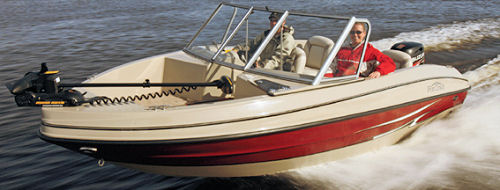 The new FinCraft 17 DC comes with a choice of 17 different engines from four different outboard engine makers…or buy the boat pre-rigged. |
The Roaring ‘50s
If you couldn’t afford a Chris-Craft (made of wood back in those days)– and most
people couldn’t – there were many other brands to buy, most of wood or aluminum.
And if you couldn’t afford those, you could buy plans from Rudder magazine for 10
bucks and make your own boat in your backyard out of ½” plywood. For $99 and coupons
from 10 packs of Kool cigarettes you could get a little lateen-rig sailboat about
the size of an Optimist pram mailed to your door!
Back in those days people had the desire to go boating, not a lot of money, but
prices were low and enthusiasm was high. The country was coming out of 15 years
of depression and war and the American middle class was growing larger and more
confident in the future every day. Fiberglass powerboats came along in the late
1950s, adding even more excitement and possibilities.
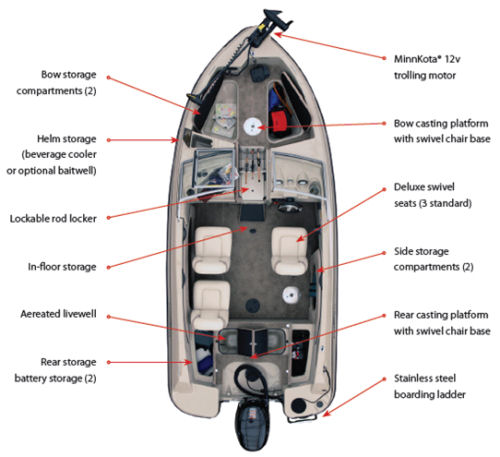 Features of the FinCraft 17 DC. |
Built for the Times
What does all of that have to do with the FinCraft 17 and 1850? We think plenty.
FinCraft boats are aimed at people – in middle America – who want to go freshwater
fishing, or who simply want to own a boat for family boating -- but who don’t like
what they see going on around them. And it is not just this year and last year,
economic “uncertainty” has been in the air for some time for many people.
A low price with low monthly loan payments may not eliminate uncertainty about the
economy and one’s job, but it certainly doesn’t add much additional anxiety at only
$136 per month. FinCraft is about the current American economy and consumer state
of mind.
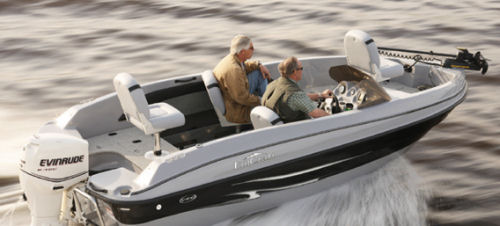 The FinCraft 17 SC model is probably easier to move around on by husky anglers because of the elimination of the port console. |
The Aluminum Market
It is also about the large numbers of aluminum boats that are (or were) annually
sold. For years Genmar owned Crestliner, Lowe and Lund, then sold them to Brunswick
for $196 million a few years back. That’s was a nice payday, but Genmar management
has never forgotten the large unit numbers that its three aluminum boat companies
cranked out year after year. By comparison, unit sales of most fiberglass boat companies,
with only a few exceptions, are quite a bit lower.
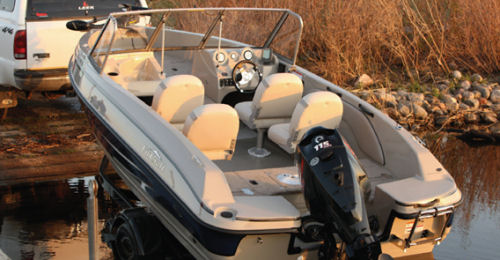 The FinCraft 1850 has seating for 6, so you can take the whole family or friends out for a spin on the lake. |
Last year Genmar announced it was going to get back into the aluminum boat business
and would be starting a new company in a year or two. Then Lehman Brothers failed
and the world changed on a dime.
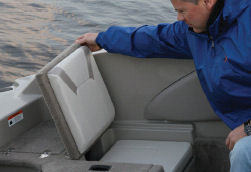 In the 1850, fold-up casting platform makes into a seat, port and starboard. |
A Strategic Master Stroke
In the midst of all the economic turmoil last fall, Genmar hit upon an idea that
would at one stroke –
a) help spread the overhead of two sportboat companies over more units,
b) deliver to the worried American fisherman “uncertain” about the future a fishing
boat so inexpensive that it would be the least of his worries,
c) grab a piece of the aluminum boat market, and,
d) launch a boat into the multi-specie freshwater fishing market.
FinCraft was born. In a matter of a few months it was on the market.
Fish Boats R Us
When it comes to entry-level fiberglass 17’ and 18’ boats, Genmar (which owns 14
boat brands) has plenty of experience. Moreover, Genmar is an old hand at fishing
boats, both freshwater and saltwater. With Ranger, Stratos, and Champion, Genmar
is a major player in the bass boat market. With Hydra-Sports, Wellcraft, Seaswirl
and Triumph the conglomerate owns four of the biggest brands in saltwater coastal
center console fishing.
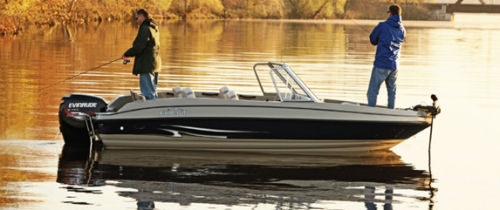 With bow and stern platforms there is plenty of room for two anglers. This is the 1850. |
The Cost-Conscious Future
Today’s customer is focusing more on value for money and less on amenities and gadgets
that drive prices up. Genmar’s central purchasing, component standardization and
volume means its materials costs are as low as they come. Several years ago the
company started consolidation of manufacturing from many locations into just a few
plants and that has saved still more money on infrastructure overhead.
Over ten years ago Genmar started building small boats with the VEC process and
today it remains the only company with the technology. With VEC, a complete fiberglass
hull with stringers and foam can be made every 30 minutes or so. Because the molding
is smooth on both sides the need for an inner liner and the extra weight is eliminated.
VEC is so scalable, economies quickly increase with production. In fact, VEC needs
big numbers in order to be efficient.
Mass Production Lowers Cost
The VEC metal dies for the 17 hull are in Little Falls, Minnesota and all spring
long they have been producing 17’ and 18’ hulls for Larson and Glastron, as well
as for the new FinCraft models. The hull moldings for the 1750 Larson and 175 Glastron
stern drive sport boats are virtually the same as for the outboard-powered FinCraft.
The same is true for the FinCraft 1850 hulls, which are outboard versions of hulls
Genmar makes for Larson and Glastron with VEC. It’s called mass production – something
that is usually an oxymoron in the boat business, particularly these days.
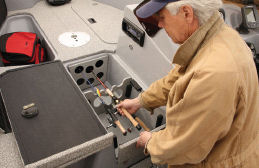 There is a lockable rod storage locker under the bow casting platform. |
As a result of all of this, FinCraft is the first fiberglass multi-specie fishing
boat that can compete with aluminum boats on price. In a price comparison we did
of several major aluminum brands in the 17’ and 18’ range, we found the FinCraft
surprisingly competitive. Genmar says that their FinCrafts are $1000 to $3000 less
than comparable aluminum boats.
Advantages of Fiberglass
By creating a viable fiberglass competitor for aluminum, relatively low-ticket multi-fishing
boats, Genmar has entered a new market. Now consumers are being presented with an
affordable fiberglass alternative with some distinct advantages. The company says
that with the VEC process…”there are no seams, square corners or sharp edges.” A
Genmar spokesman told us that VEC allows them to produce a fishing boat with curves,
a rounded sheer line and molded in recesses for cleats and hardware. And it is true,
there are styling and design shapes that can not be duplicated in aluminum.
Surprisingly, FinCrafts are also very close to many of its aluminum competitors
in weight as well. Low weight has always been an important advantage of aluminum
boats because of the inherent fuel efficiency both while running and towing. For
example, when we compared the FinCraft 17’ with major aluminum brands in similar
configurations, we found the FinCraft to be within 200 lbs. of many and actually
about the same as some. Weight is not a drawback for the FinCraft.
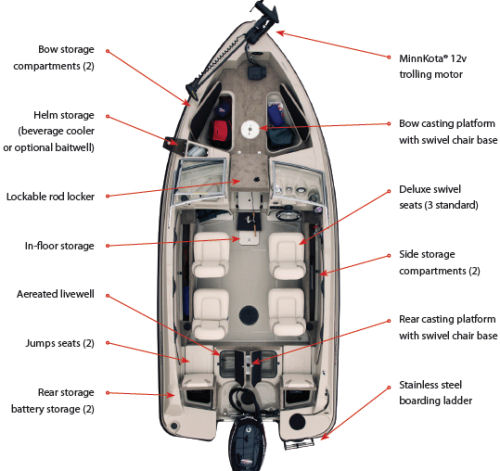 Features of the FinCraft 1850. |
Specs and Prices
The basic specs of the FinCraft 17’ boat are 16’11” LOA, 7’4” beam, 2'7” draft,
21-degree dead rise at the transom, and 1,450 lbs. displacement. She has a 23 gallon
fuel tank. The standard boat comes with a 50-hp Yamaha 2-stroke carbureted outboard
for $14K. FinCraft offers the boat with engine options up to 115-hp from Yamaha,
Suzuki, Evinrude and Mercury. MSRP with the Yamaha F115 is $20,475.
The boats will also be available “pre-rigged” for Evinrude, Suzuki, Yamaha or Mercury
engines for about $11K MSRP for the 17’ and for about $16K for the 1850.
The boat comes standard with pretty much everything you can see in addition to the
engine, including a 12V Minnkota trolling motor, Lowrance depth sounder, three swivel
seats, an aerated livewell, a boarding ladder, lots of storage, and custom painted
trailer, along with the normal list of gauges, pumps, cleats, etc.
The 1850 measures 18’6”, 7’10” beam, 3’8” draft, and 1820 lbs. displacement. The
cockpit has a depth of 29-1/2” which is relatively deep and makes the boat dryer
and safer than lower freeboard boats. The 1850 has all of the standard equipment
that the 17 has, plus a walk-thru windshield, a Lowrance depth sounder, and stern
platform flip-up seats.
Boat Tests Coming Soon
We have not yet tested the two new FinCraft models but we are planning to in the
very near future. These tests will answer a lot of questions, such as what is the
smallest engine that will give the boat decent performance with three or four men
aboard? How much fuel will she burn at best cruise and what is her range? How stable
will the boat be with its semi-deep-V-hull? Is she wet and if so in what conditions?
What is the trim angle getting on plane? What is the caliber of her fit and finish?
How strong is the torque in the steering? We’ll answer these questions and others
in our performance tables and the Captain’s Report.
In the meantime, we’d like to hear what your questions are, and what your thoughts
are relative to a fiberglass boat dedicated to multi-specie fishing…
As you might imagine with FinCraft being launched so fast, its dealer network is
still in the process of being set up.
If you are interested in knowing more about the FinCraft line or in contacting a
dealer, click here…
